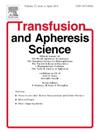α -1抗胰蛋白酶在急性移植物抗宿主病治疗中的作用是什么?
IF 1.4
4区 医学
Q4 HEMATOLOGY
引用次数: 0
摘要
目的:急性移植物抗宿主病(GVHD)发生在20- 80% %接受同种异体造血干细胞移植(alloo - hsct)的患者中。在这些患者中,40% %将对类固醇产生耐药性,这是标准的一线治疗方法。对于类固醇难治性急性GVHD (SR-aGVHD)患者,没有标准的二线治疗方法。α -1抗胰蛋白酶是一种蛋白酶抑制剂,具有抗炎和免疫调节特性。在这里,我们报告了17例使用α -1抗胰蛋白酶治疗SR-aGVHD的患者的结果和安全性数据。材料和方法:在日本5个移植中心接受至少2行α -1抗胰蛋白酶治疗的SR-aGVHD患者被纳入本回顾性研究。结果:α -1抗胰蛋白酶治疗系患者接受治疗的中位数为4例(范围2-5)。从α -1抗胰蛋白酶给药到缓解的中位时间为65天(范围10-138天)。总有效率为70.6 %。当根据GVHD受累器官比较第一个月和第二个月的反应率时,我们发现皮肤、肝脏和胃肠道系统受累的反应率相似(p = 0.281和p = 0.305)。α -1抗胰蛋白酶治疗后未见3-4级贫血、血小板减少或中性粒细胞减少。巨细胞病毒感染2例,肺炎1例。在中位随访7个月时,总生存率为70.6 %,中位总生存率未达到。结论:α -1抗胰蛋白酶是SR-aGVHD患者有效且安全的治疗选择,在累及皮肤、肝脏和胃肠道系统的患者中,其有效率高达70% %。需要更大规模的研究来确定SR-aGVHD患者的标准第二次和后续治疗方法。本文章由计算机程序翻译,如有差异,请以英文原文为准。
What is the role of alpha-1 antitrypsin in the management of acute graft versus host disease?
Objective
Acute graft versus host disease (GVHD) occurs in 20–80 % of patients undergoing allogeneic hematopoietic stem cell transplantation (allo-HSCT). Of these patients, 40 % will be resistant to steroids, which is the standard first-line approach. There is no standard second line treatment approach for patients with steroid refractory acute GVHD (SR-aGVHD). Alpha-1 antitrypsin is a protease inhibitor and has anti-inflammatory and immune regulatory properties. Here we report the outcomes and safety data of 17 patients treated with alpha-1 antitrypsin for SR-aGVHD.
Material and methods
Patients who received at least 2 lines of alpha-1 antitrypsin treatment for SR-aGVHD at five transplant centers in Türkiye were included in this retrospective study.
Results
The median number of alpha-1 antitrypsin treatment line patients received was 4 (range, 2–5). The median time between alpha-1 antitrypsin administration and response was 65 days (range, 10–138 days). Overall response rate was 70.6 %. When the first- and second-month response rates were compared according to GVHD organ involvement, we found that the response rates were similar in skin, liver and gastrointestinal system involvement (p = 0.281 and p = 0.305, respectively). No grade 3–4 anemia, thrombocytopenia or neutropenia was observed after alpha-1 antitrypsin treatment. Two patients had cytomegalovirus infection and 1 patient had pneumonia. At a median follow-up of 7 months, overall survival was 70.6 % and median overall survival was not reached.
Conclusion
In conclusion, alpha-1 antitrypsin is an effective and safe treatment option in patients with SR-aGVHD, with response rates of up to 70 % in patients with skin, liver and gastrointestinal system involvement. Larger studies are needed to establish a standard second and subsequent treatment approach in patients with SR-aGVHD.
求助全文
通过发布文献求助,成功后即可免费获取论文全文。
去求助
来源期刊
CiteScore
3.60
自引率
5.30%
发文量
181
审稿时长
42 days
期刊介绍:
Transfusion and Apheresis Science brings comprehensive and up-to-date information to physicians and health care professionals involved in the rapidly changing fields of transfusion medicine, hemostasis and apheresis. The journal presents original articles relating to scientific and clinical studies in the areas of immunohematology, transfusion practice, bleeding and thrombotic disorders and both therapeutic and donor apheresis including hematopoietic stem cells. Topics covered include the collection and processing of blood, compatibility testing and guidelines for the use of blood products, as well as screening for and transmission of blood-borne diseases. All areas of apheresis - therapeutic and collection - are also addressed. We would like to specifically encourage allied health professionals in this area to submit manuscripts that relate to improved patient and donor care, technical aspects and educational issues.
Transfusion and Apheresis Science features a "Theme" section which includes, in each issue, a group of papers designed to review a specific topic of current importance in transfusion and hemostasis for the discussion of topical issues specific to apheresis and focuses on the operators'' viewpoint. Another section is "What''s Happening" which provides informal reporting of activities in the field. In addition, brief case reports and Letters to the Editor, as well as reviews of meetings and events of general interest, and a listing of recent patents make the journal a complete source of information for practitioners of transfusion, hemostasis and apheresis science. Immediate dissemination of important information is ensured by the commitment of Transfusion and Apheresis Science to rapid publication of both symposia and submitted papers.

 求助内容:
求助内容: 应助结果提醒方式:
应助结果提醒方式:


